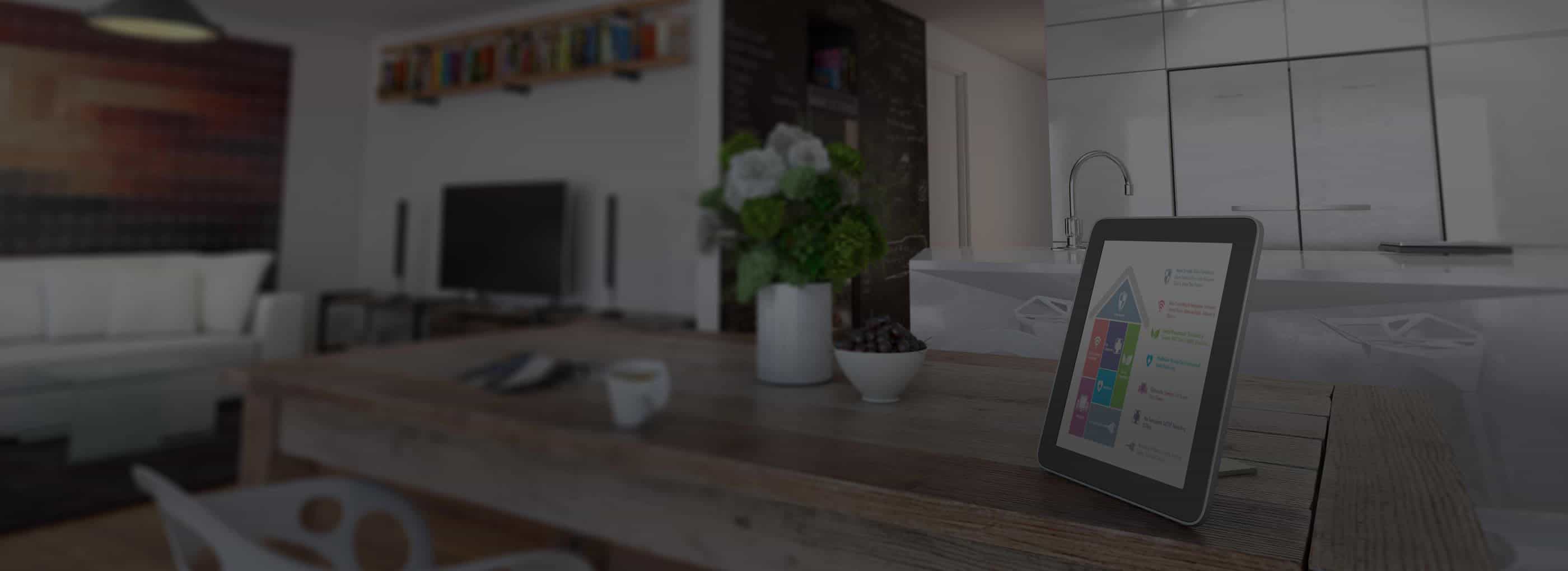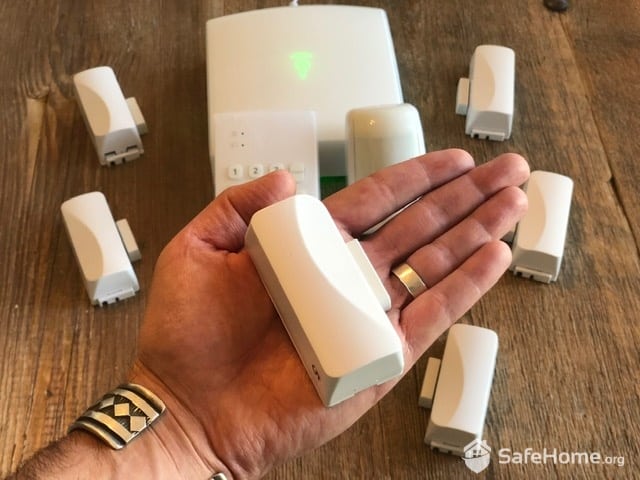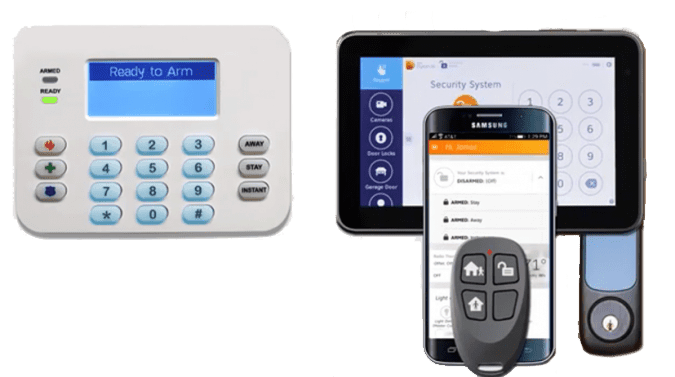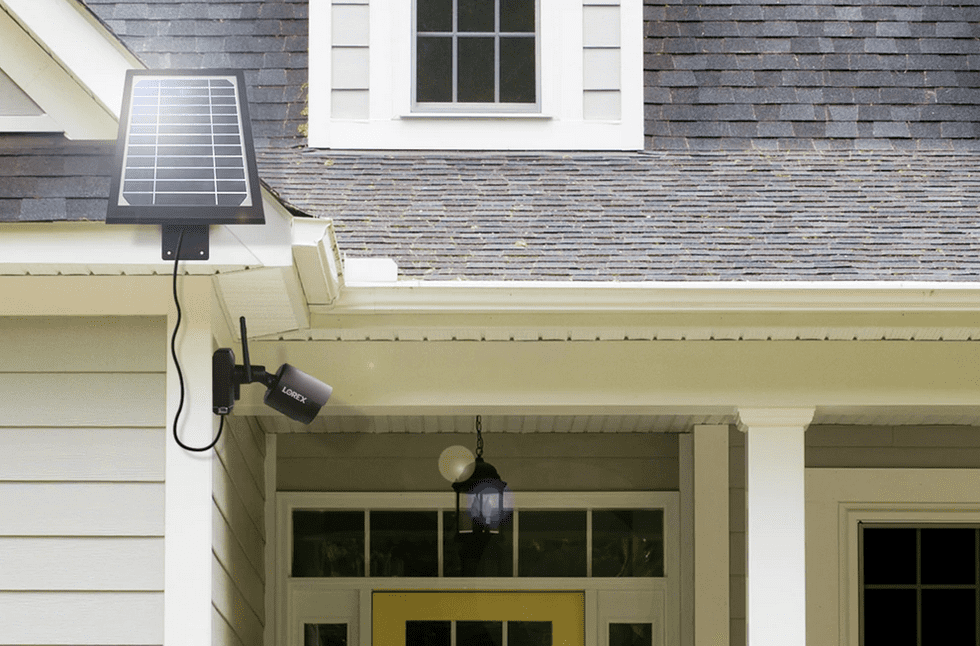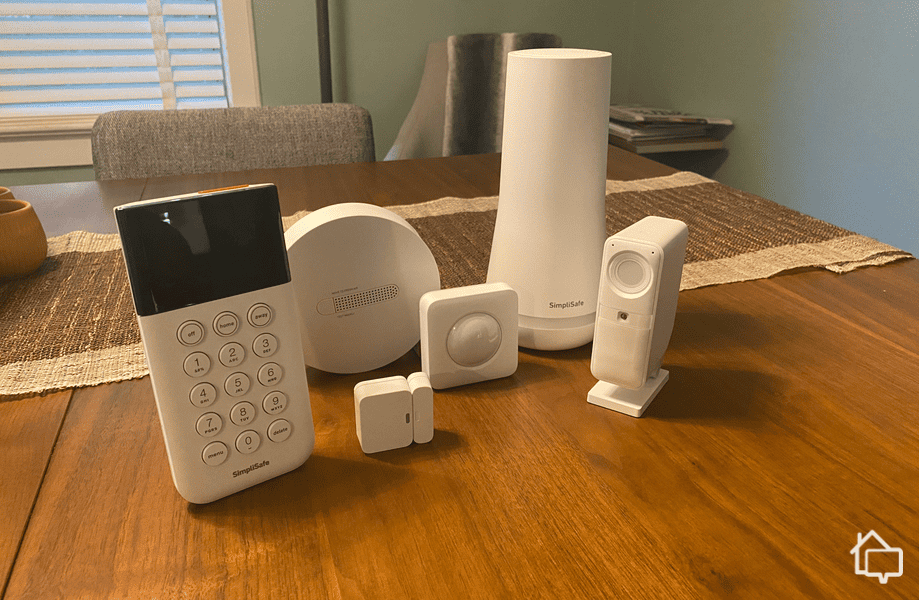The average U.S. household experienced over 10 hours of power interruptions in 2024.1 That’s an awfully long time to be without electricity, especially if you have critical equipment relying on it, such as a home security system.
We found that for most homes, the built-in battery backup of security systems is enough to keep core features running, but not security cameras. If you want your entire security system running through power outages, keep reading this guide put together by our resident home security system experts.
How Much Power Do You Need to Keep A Security System Running?
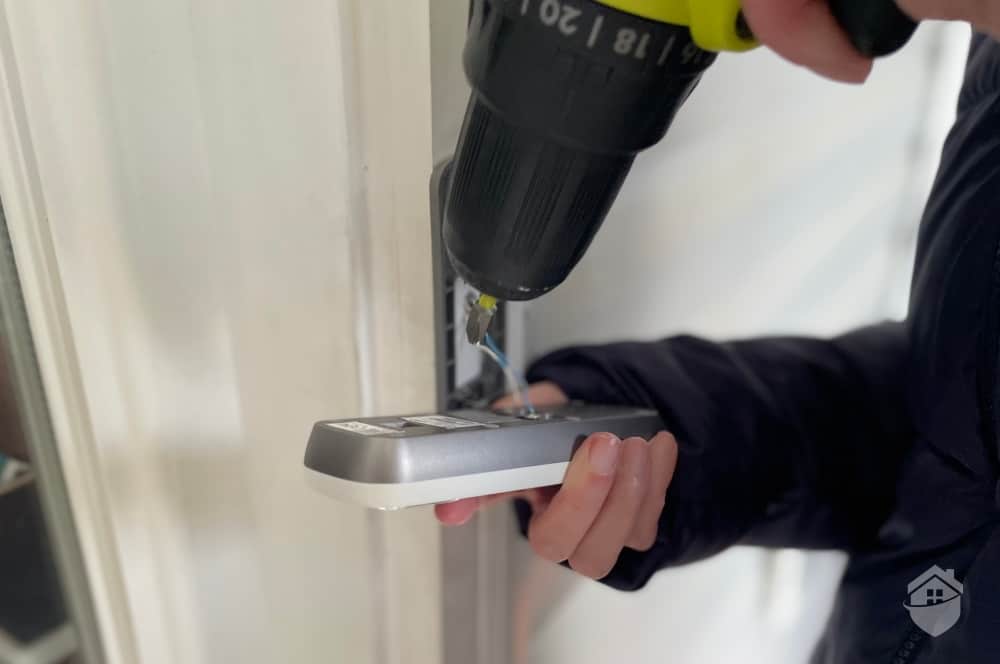
Our Lorex Wired Video Doorbell drew about three watts of electricity.
Smart security systems consume relatively little power compared to major household appliances. One of the basic security systems we own with a control panel, keypad, and six sensors draws 2 to 5 watts during normal operation.
Of course, other components might require more power. If our smart plug is right, the Nest Cam (indoor, wired) we tested draws about 7 to 8 watts. If you have multiple smart home devices and security cameras, your security system is probably drawing anywhere from 20 to 40 watts, equivalent to a single computer monitor.
The key challenge lies in understanding peak versus continuous power demands. During an alarm event, power consumption can spike 300 to 500% as sirens activate, cameras begin recording, and cellular modules transmit data.
We measured the power consumption of each component in our eight favorite security systems during standby mode and alarm events. Here are the results:
- Basic control panels: 1-3 watts
- Wireless sensors: 0.1-0.5 watts each (battery-powered)
- Indoor cameras: 2-8 watts each
- Outdoor cameras with night vision: 5-15 watts each
- Smart door locks: 1-4 watts each
FYI: You can calculate the power requirements of your system by adding up the wattage of each component. Typically, home security providers list the wattage of their components in the technical specs. Otherwise, you can use a power meter or a smart plug with energy monitoring to measure each component’s wattage yourself.
Types of Battery Backup Solutions
Once you know how much power your security system requires, you can start finding practical battery backup solutions. Here’s an overview of each option and the results of our tests.
Uninterruptible Power Supplies (UPS)
UPS systems represent the most straightforward battery backup solution for smart alarms. These devices provide immediate power switching (typically within 4 to 10 milliseconds) which any component plugged into them won’t need to reboot. Consumer-grade UPS units work well for powering security system base stations and security cameras.
What We Like:
- Plug-and-play installation
- Automatic voltage regulation
- Surge protection beyond just battery backup
- Most models include software for monitoring battery health
What We Don’t Like:
- Limited runtime capacity (15 to 30 minutes for cheaper models)
- Requires battery replacement every 3 to 5 years
Portable Power Stations
Portable power stations have evolved from camping accessories to legitimate home backup solutions. These lithium-ion battery systems offer a significantly longer runtime than traditional UPS units. A power station we borrowed from a friend lasted 26 hours with one base station and two indoor cameras plugged in.
What We Like:
- Can power a security system for days
- Easy to use and set up
- Pricier models offer UPS modes enabling instantaneous switching during power outages
What We Don’t Like:
- Relatively expensive compared to UPSes
- Standard models take time to turn on during a power outage
- Must avoid overcharging or fully discharging to maintain battery health
Dedicated Security System Batteries
Professional security installers often recommend dedicated backup batteries designed specifically for alarm systems. These solutions integrate directly with the security panel’s charging circuit and provide seamless backup power without external devices. The top security systems we tested – ADT, SimpliSafe, and Vivint – all have battery backup rated for up to 24 hours of continuous use.
What We Like:
- Direct integration eliminates power conversion losses
- Most reliable backup power switching
- Professional batteries often include temperature compensation and smart charging features that extend battery life.
What We Don’t Like:
- Installation typically requires professional assistance and knowledge of your specific security panel’s requirements
- More expensive than equivalent-capacity consumer solutions
- Most jurisdictions regulate the disposal of lead-acid batteries
Whole-Home Battery Systems
Whole-home battery systems provide the ultimate security system protection. Traditionally, these systems were used to store excess solar power. Systems like the Tesla Powerwall, Enphase Encharge, or LG Chem RESU maintain power to an entire home, including security systems. While we haven’t tested whole-home battery systems, they should be the most reliable battery backup solution if they’re within your budget.
What We Like:
- Long lasting power to an entire security system, including lighting
- Homes with solar panel systems likely already own a whole-home battery system
- Offers alternative cost-saving uses, such as activation during peak demand times to lower electricity bills
What We Don’t Like:
- By far the most expensive battery backup solution (avg. $15,000)
- Complicated installation process
- Requires ongoing maintenance to maximize battery life
Key Features for Security System Battery Backup Solutions
Regardless of which type of battery backup solution you opt for, there are a few features we find critical for use with a security system.
Battery Capacity and Runtime

The base station for our ADT security system has a built-in backup battery that lasts up to 24 hours
Battery capacity, measured in watt-hours (Wh) or amp-hours (Ah), determines how long your backup system will sustain your alarm system. However, there are a few other factors to consider to assess real-world runtimes:
- Inverter Efficiency: Cheaper backup systems may waste 15 to 25% of stored energy converting DC battery power to AC household current.
- Battery Chemistry: Lithium-ion batteries maintain consistent voltage throughout discharge, while lead-acid batteries experience voltage drops that can affect sensitive electronics such as security cameras.
- Temperature Effects: Cold conditions can reduce effective battery capacity by 20-40%.
Automatic Transfer Speed
Transfer speed — the time between power loss detection and backup power activation — matters more for some alarm components than others. Modern base stations include internal batteries that easily bridge 10 to 30 millisecond transfer delays. That means they won’t reboot as long as power is restored within that period.
However, connected devices like hardwired cameras may need to reboot due to the transfer delay causing a further delay until your system is fully operational again.
UPS systems provide the fastest transfer speeds at 4 to 10 milliseconds. Portable power stations with UPS modes typically transfer within 10 to 30 milliseconds. Basic power stations without UPS functionality may take 100 to 500 milliseconds, often requiring device reboots.
>> Check Out: Best Wired Home Security Camera Systems of 2025
Surge Protection and Power Conditioning
We find that quality backup power solutions provide more than just battery backup. Surge protection protects sensitive alarm components from voltage spikes when power comes back on. We recommend looking for surge protection guards with the following capabilities:
- Surge energy ratings of 1,000+ joules
- Automatic voltage regulation (AVR) to correct brownout conditions
- Pure sine wave output for sensitive electronics
- EMI/RFI filtering to reduce electrical interference
Pro Tip: Avoid modified sine wave backup systems for smart alarms, as the distorted waveform can cause communication errors with wireless sensors and cellular modules.
Installation and Setup Guidelines
Some battery backup systems require professional installation whereas others you can install yourself. Here’s a look at when you might need professional installers as well as a few setup tips we learned during our time testing 14 different systems.
Professional vs. DIY Installation
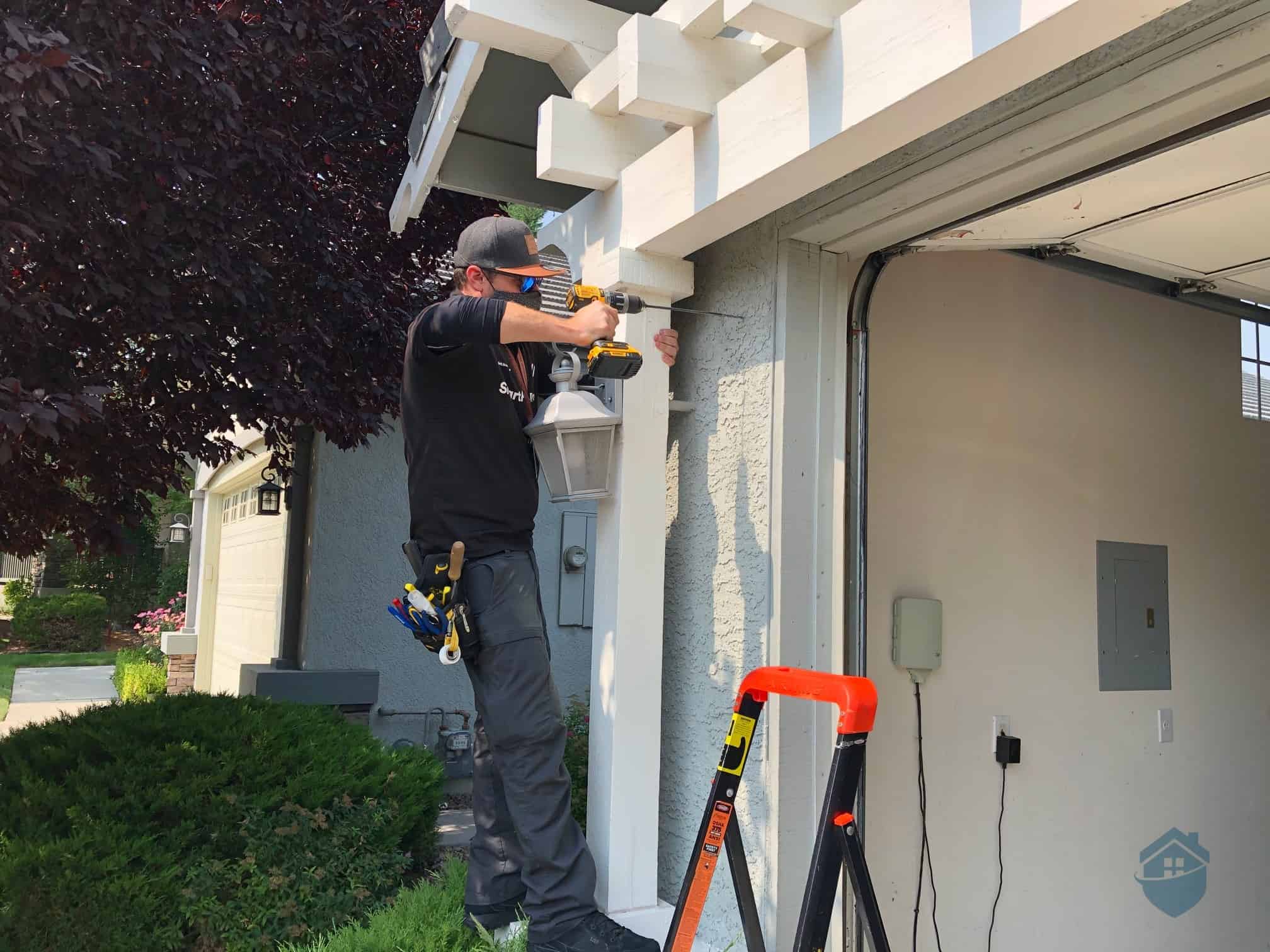
Vivint sent a highly qualified technician to install our hardwired security components.
Most homeowners can install UPS systems and portable power stations without professional assistance. These solutions typically require only plugging your security system’s power adapter into the backup device and connecting the backup device to wall power.
However, if your security or battery backup system fits any of the following criteria, we recommend hiring a professional:
- Hardwired alarm panels may require electrical work to add backup power connections.
- Whole-home battery systems require electrical permits and utility interconnection agreements.
- High-capacity dedicated batteries often need mounting and proper ventilation considerations.
>> Read More: Best Professionally Installed Home Security Systems of 2025
Optimal Placement and Ventilation
Battery backup systems generate heat during charging and discharging cycles. Proper placement ensures reliable operation and extends battery life. Here are the most important considerations when deciding where to install your battery backup system:
- Temperature Range: Most systems operate optimally between 60-80°F
- Ventilation: Allow 6+ inches clearance around cooling vents
- Accessibility: Place units where you can easily check status lights and replace batteries
- Security: Consider backup system security—a visible UPS signals valuable electronics to potential burglars
We suggest avoiding basement locations prone to flooding and attics with extreme temperature swings. We find that utility rooms, home offices, and bedroom closets typically provide the most ideal environments.
Integration with Existing Systems
Modern smart alarm systems often include multiple communication pathways that complicate backup power planning. A typical system might include:
- Primary broadband internet connection for cloud monitoring
- Cellular backup module for communication redundancy
- Local Wi-Fi network for smartphone app connectivity
- Landline connection backup (less common in modern systems)
Comprehensive backup power protection requires powering not just the alarm panel, but also your internet modem, Wi-Fi router, and cellular signal boosters. Network equipment typically adds 15-30 watts to your backup power requirements.
Did You Know? Many internet service providers offer battery backup modules for their modems and routers. Check with your ISP about options before purchasing separate backup power.
Cost Analysis and ROI
Now that you know all about your options for battery backup systems and how they work, let’s figure out the cost of a system that will work for you.
Upfront Investment Ranges
Battery backup solutions span a wide price range depending on capacity, features, and installation requirements:
| Solution Type | Price Range | Typical Runtime | Installation |
|---|---|---|---|
| Basic UPS | $100 to $300 | Up to 12 hours | DIY |
| Advanced UPS | $300 to $800 | Up to 24 hours | DIY |
| Portable Power Station | $500 to $2,000 | Up to seven days | DIY |
| Dedicated Security Battery | $200 to $600 | Up to three days | Professional |
| Whole-Home Battery | $10,000 to $20,000 | Up to fourteen days | Professional |
These costs exclude ongoing maintenance and battery replacement. According to our research, UPS systems typically require new batteries every 3 to 5 years at $30 to $150 per replacement. Lithium-ion power stations may need battery service after 7 to 10 years, often costing 40-60% of the original purchase price.
Long-term Maintenance Costs
Lead-acid batteries in UPS systems degrade predictably, losing 20% capacity after three years and requiring replacement by year five. Lithium-ion systems maintain capacity longer but cost more upfront.
Over 10 years, you can expect a basic $150 UPS system to require two battery replacements at $40 each for a total cost of $230. A lithium power station costing $1,000, on the other hand, would need one battery service costing about $400 for a total cost of $1,400.
Insurance and Security Value
While difficult to quantify precisely, backup power for security systems provides measurable value through:
- Reduced insurance claims from theft during power outages
- Maintained monitoring service credits (many services offer billing credits for extended outages)
- Peace of mind value during severe weather events
Some insurance providers offer discounts for top-quality monitored home security systems with documented backup power capabilities. Contact your insurance agent to discuss potential savings.
Maintenance and Best Practices
To maximize the lifespan of your backup battery system, we strongly recommend conducting regular maintenance. Here are a few best practices.
Regular Testing Procedures
Just like we regularly test our security cameras, we also regularly test our battery backup systems.
Periodic testing ensures reliable operation when needed. Most UPS systems include self-test features that automatically check battery condition monthly. However, we find that manual testing provides more thorough verification. Here’s a step-by-step guide for testing your battery:
- Simulate power outage by unplugging the backup system while connected devices are running
- Verify immediate transfer with no device reboots or alarm system errors
- Check runtime by timing how long the system operates on battery power
- Monitor battery voltage using the system’s display
Expert Recommendation: Set smartphone reminders for testing schedules, and keep a simple log of test results to identify performance trends over time.
Battery Health Monitoring
Some modern backup systems we tested include sophisticated battery monitoring that tracks charge cycles, temperature exposure, and capacity degradation. The following warning signs indicate that your battery health is compromised:
- Reduced runtime compared to previous tests
- Frequent low battery alarms during normal operation
- Extended recharge times after power outages
- Battery replacement indicators on system displays
Seasonal Considerations
We find that battery performance varies significantly with temperature and humidity changes. Summer heat accelerates battery aging, while winter cold reduces available capacity. Adjust your maintenance routine seasonally:
| Summer Preparation | Winter Preparation |
|---|---|
|
|
Recap: Choosing a Battery Backup Solution for Your Security System
Reliable backup power ensures you receive 24/7 protection from your smart alarm system even during power outages. They don’t need to cost an arm and a leg, either, with basic systems starting at about $150.
To choose the right battery backup solution for your smart alarm system, start with a thorough assessment of your current security system’s power requirements. Then, choose backup solutions that provide adequate runtime based on the stability of the power grid in your region.
Frequently Asked Questions
- How long should my security system battery backup last during an outage?
Most security professionals recommend backup power for at least 24-48 hours of normal operation. This covers typical weather-related outages and provides time to arrange generator backup for extended events.
- Can I use a car battery to backup my alarm system?
While technically possible, automotive batteries aren’t designed for the deep discharge cycles required for backup power applications. Use sealed lead-acid or lithium batteries specifically designed for backup power to ensure reliable operation and safety.
- Do I need to backup my internet connection for my smart alarm to work?
Most modern smart alarms include cellular backup modules that maintain monitoring service even without internet connectivity. However, features like smartphone alerts and remote camera viewing typically require internet access, making network backup worthwhile for full functionality.
- How often should I replace UPS batteries?
Standard lead-acid UPS batteries typically last 3-5 years depending on usage, temperature, and charge cycles. Replace batteries when runtime drops below 50% of original capacity or when the UPS displays battery replacement warnings.
- Will a battery backup system work with my existing alarm system?
Most plug-in alarm systems work with standard UPS or power station backup solutions without modification. Hardwired systems may require professional installation of dedicated backup batteries integrated with the alarm panel’s charging circuit.
- What size backup system do I need for my smart alarm?
Calculate your system’s total power draw by adding up all components, then multiply by 24-48 hours for your desired runtime. Add a 25% buffer for efficiency losses and peak power demands during alarm events.

